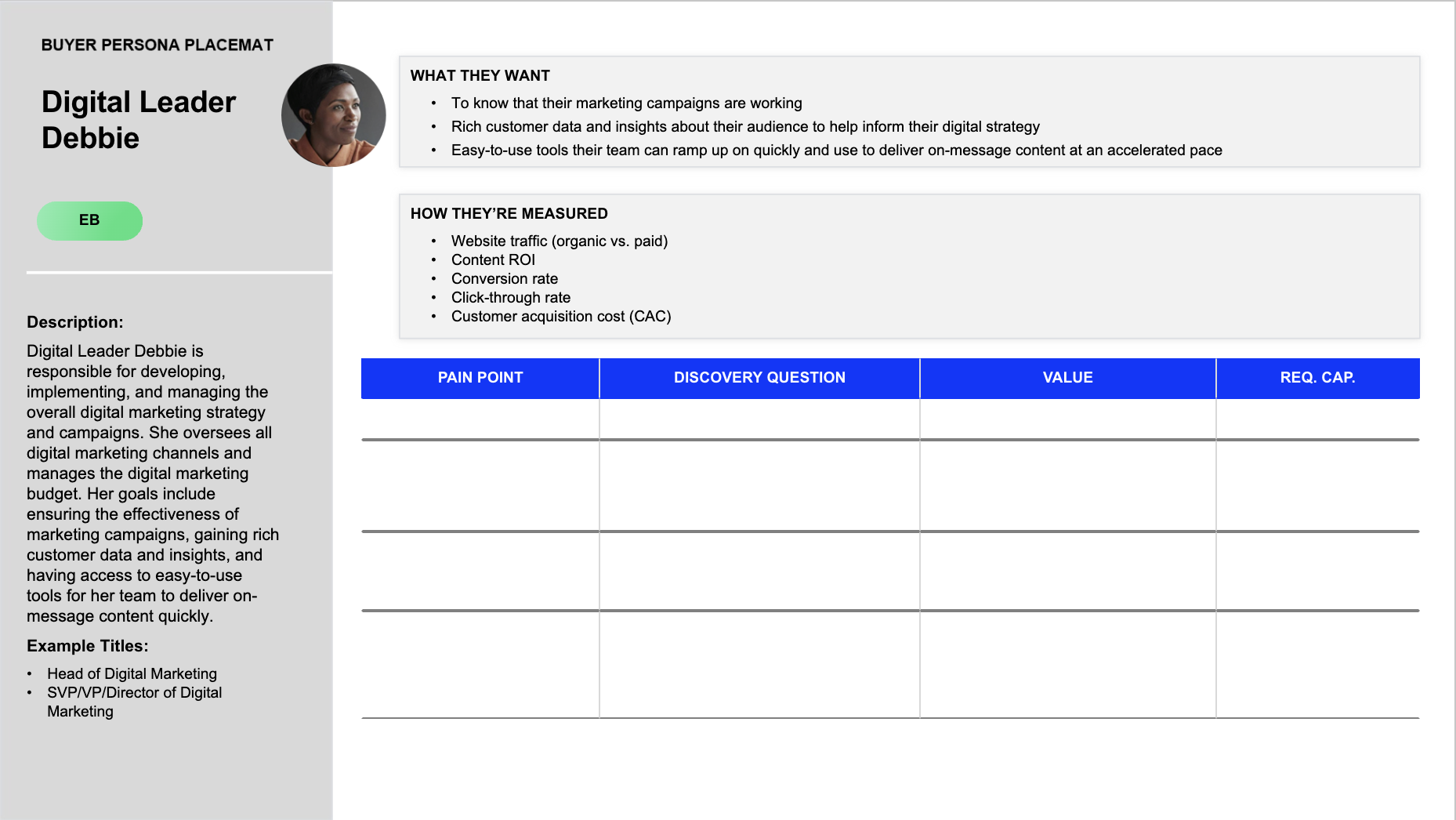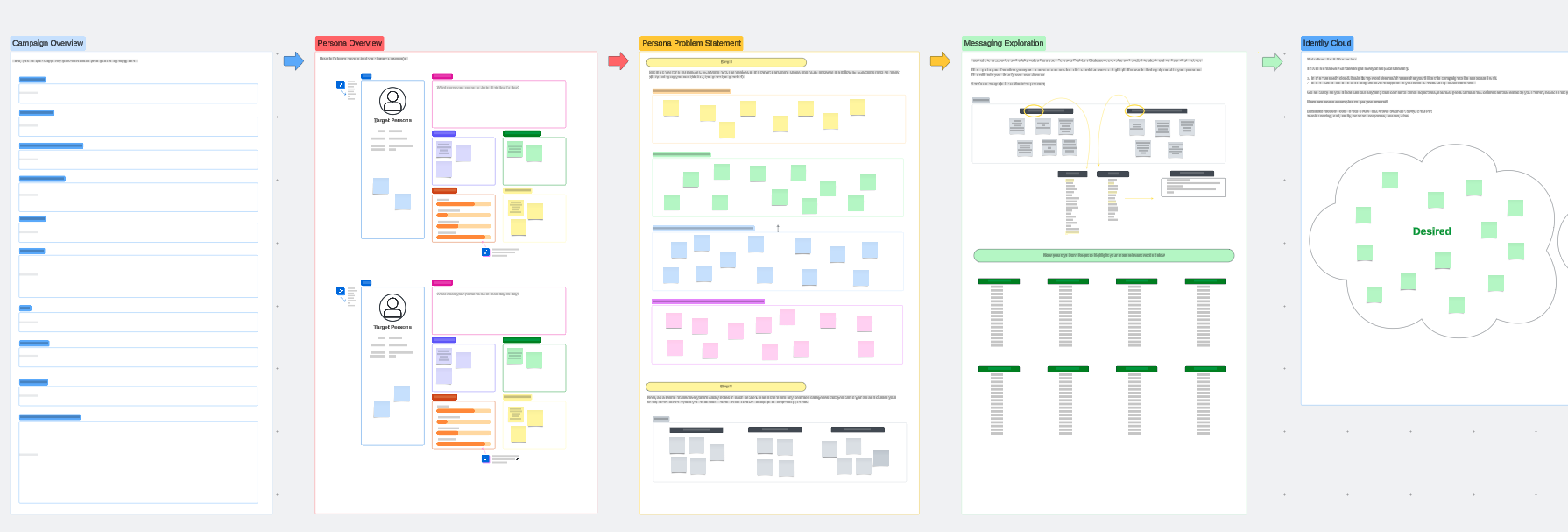Schritt für Schritt: Brainstorming für eine kreative Marketingkampagne (+ kostenlose Vorlage)


Stellen Sie sich Folgendes vor: Sie sitzen in einem Raum mit einem leeren Whiteboard, bewaffnet mit nichts als Ihrer Vorstellungskraft und einem Haufen farbiger Stifte, bereit, etwas Großes, Kühnes und Umwerfendes zu schaffen.
... oder vielleicht nicht so bereit. Schon gut, Leute - Sie befinden sich in einem sicheren Raum und wir können zugeben, dass unsere Vorstellungskraft nicht immer auf Hochtouren läuft. Kreatives Burnout gibt es wirklich.
So oder so ist es an der Zeit, mit der Brainstorming-Sitzung für Ihre Marketingkampagne zu beginnen.
Und warum? Weil Brainstorming zu neuen Ideen inspiriert, die Grenzen des B2Boooooring-Marketings verschiebt, die Zusammenarbeit in Ihrem Team fördert und die Dinge ein wenig mehr Spaß machen.
Lassen Sie uns Schritt für Schritt durchgehen, wie Sie ein Brainstorming für eine kreative Marketingkampagne durchführen können - sei es an einem virtuellen Whiteboard oder im Büro (mit Ihren zahlreichen Stiften).
Wenn Sie in Zeitnot sind, können Sie direkt zu Ihrer kostenlosen Vorlage für ein kreatives Brainstorming übergehen .
Bevor Sie mit dem Brainstorming beginnen
Bevor Sie mit dem Brainstorming für Ihre nächste kreative Marketingkampagne beginnen, sollten Sie ein wenig Ordnung schaffen... denn niemand mag ein Meeting ohne "Fleisch" (sorry, Veganer).
Sorgen Sie dafür, dass sich alle Meetings und Brainstorming-Sitzungen für alle lohnen, indem Sie die Grundlagen schaffen, damit relevante Kreativität gedeihen kann. 🌸
Schritt #1: Kennen Sie Ihr Publikum
Der beste Weg, eine kreative Kampagnenidee zu finden, die *wirklich* funktioniert, besteht darin, Ihre Zielgruppe wirklich, wirklich gut zu kennen. Sie brauchen demografische Daten, aber Sie müssen auch verstehen, wie deren Leben aussieht und wie Ihr Produkt in dieses Leben passt.
Wie der Storytelling-Experte Jonah Sachs sagt: "Gute Vermarkter sehen die Verbraucher als vollständige menschliche Wesen mit allen Dimensionen, die echte Menschen haben."
Speziell in der B2B-Welt können Sie beginnen, Ihre Zielgruppe wirklich zu kennen, indem Sie diese Fragen beantworten:
- Wie messen Ihre Käufer/Nutzer ihren Erfolg?
- Was hindert sie daran, ihre Ziele zu erreichen?
- Was lieben sie an ihrer Arbeit? Was ist daran schwierig?
Mit anderen Worten: Was wird Ihren Kunden davon abhalten, dieses Jahr seinen Bonus zu bekommen?
Und für B2C gilt Ähnliches... nur weniger "Erfolgs"-Metriken, sondern eher Schmerzpunkte oder andere Nutzervorteile. Verwandeln Sie Ihr Angebot von etwas, das der Kunde vorher nicht kannte, in ein "Das brauche ich jetzt".
Denken Sie bei diesen Dingen immer so, als ob Sie in ihrer Haut stecken würden. Um tiefer in diese (idealerweise nicht stinkenden) Schuhe einzutauchen, sollten Sie das Beste aus den Teams machen, die Sie um sich herum haben, indem Sie mit ihnen sprechen:
- Dem Vertrieb: Hören Sie sich an, mit welchen Interessenten und Leads sie sprechen und welche Probleme zu diesen Gesprächen führen.
- Account Manager: Wenn Sie enge Beziehungen zu Ihren Kunden haben, können Sie erfahren, was diese von einem Produkt und von Inhalten erwarten - und Sie können sie bei der Kundenbindung, bei Upsells und bei der Pflege von Kundenbeziehungen unterstützen.
- Kundenerfolg: Erkennen Sie Lücken in Ihren Inhalten und entwickeln Sie Ideen für Inhalte, die helfen, Probleme zu lösen oder Kunden zu begeistern.
- Produktmarketing: Niemand versteht das Messaging und die Positionierung einer Marke so gut wie das Produktmarketing - stellen Sie sicher, dass jede Stufe des Trichters mit relevanten Inhalten gefüllt ist.
Sobald Sie diesen Schritt abgeschlossen haben, werden Ihnen wahrscheinlich schon einige Ideen durch den Kopf gehen.

Schritt #2: Erstellen und vereinbaren Sie Ihre Ziele
Sie wissen, mit wem Sie sprechen, also bringen Sie die Sache wieder ins Haus. Was will Ihr Team mit dieser Kampagne erreichen?
Wenn Sie den Bekanntheitsgrad Ihres Unternehmens erhöhen oder eine Aktion auslösen wollen, sieht das ganz anders aus, wenn Sie diese Ideen zum Leben erwecken.
Wenn sich alle Beteiligten auf die Marketingziele, die Kampagnenziele und die individuellen Ziele innerhalb der Kampagne einigen, haben Sie die Grundlage, damit die Mitarbeiter wissen, was auf sie zukommt... und was sie zu Beginn des Meetings zu tun haben.
Schritt #3: Legen Sie Ihre Kanäle und Ihr Budget fest
Wo und wann wird Ihre Kampagne stattfinden? Der Unterschied zwischen einer sozialen Kampagne und der Planung eines gesponserten Abendessens für geladene Gäste bestimmt natürlich die Aktivitäten und Assets, die Sie benötigen - also beginnen Sie mit der Planung.
Gibt es Fragen oder Dinge, die noch nicht festgelegt sind? Bereiten Sie sich auf verschiedene Optionen vor und bringen Sie Ihre Fragen in die Brainstorming-Sitzung mit.

Kommen wir zum Spaß: Es ist Zeit für ein Brainstorming!
Abgehakt, abgehakt, abgehakt 👈 Damit haben Sie Ihre Marketing-Brainstorming-To-do-Liste abgearbeitet. Jetzt ist es an der Zeit, Ihre kreative Ader in Gang zu bringen.
Optimizely is a 8x Leader in CMPs!
Schritt #4: Führen Sie Ihre Brainstorming-Sitzung durch
Sie haben Ihre Leitplanken und Ihren Rahmen festgelegt und es ist nun endlich an der Zeit, die Ideen zu Papier zu bringen.
Um Ihre Brainstorming-Sitzung in Gang zu bringen, können Sie einige der folgenden Techniken anwenden:
- Brainstorming der schlechten Ideen: Setzen Sie eine Zeit fest und schreiben Sie die schlimmsten Ideen auf, die Ihnen einfallen. Warum funktioniert das? Weil Sie Ihr Gehirn mit einem Trick dazu bringen, ein Problem kreativ zu lösen, indem Sie alle Ideen identifizieren, die niemals das Licht der Welt erblicken sollten. David Ogivly sagte, dass die besten Marketingideen als Witze beginnen, und es gibt kein besseres Mantra für diese Brainstorming-Technik.
- Brainwriting: Sie hassen die schnelle Ideenfindung? Versuchen Sie Brainwriting. Bei dieser Technik lesen Sie eine Frage oder Problemstellung und schreiben dann Ihre Ideen auf. Dann geben Sie Ihr Papier an die nächste Person weiter und machen so lange weiter, bis jeder seinen Beitrag zu allen Zetteln geleistet hat.
- Starbursting: Wir lieben eine Partie Jeopardy, daher ist Starbursting ein tolles Spiel für unser Team. Anstatt zu versuchen, ein Problem zu lösen, denken Sie sich Fragen aus, die mit der Idee zusammenhängen, und listen sie auf.
Hier sind einige Brainstorming-Techniken, die unser Team bei unserem letzten Kampagnen-Brainstorming in der Praxis eingesetzt hat. Sie können eine beliebige Mischung dieser Techniken, einige von ihnen oder alle verwenden, um zu Ihrem endgültigen Kampagnenkonzept zu gelangen.
- Problemstellung der Persona
- Erkundung der Botschaften
- Identitätswolke
- Nordstern
Nach Ihrem Brainstorming
Oder man könnte sagen: die Ruhe nach dem (Gehirn-)Sturm. 🥁 Wir sind die ganze Woche hier.
Schritt #5: Erstellen Sie Ihr Inspirationsprotokoll oder Moodboards
Ein wichtiger Teil des kreativen Prozesses ist es, Ihre Ideen festzuhalten und sie für die Hochphase vorzubereiten. Wenn Sie in letzter Zeit kein Inspirationsprotokoll oder Moodboard verwendet haben, lohnt es sich, sich daran zu erinnern, wie dieser Prozess aussehen und wofür er verwendet werden kann.
Moodboards können so viel mehr als nur Notizen oder statische Informationen enthalten: Sie können Videos, Links und - was noch wichtiger ist - Mitwirkende hinzufügen. Und das Beste ist, dass sie so aussehen können, wie Sie wollen - lassen Sie sich doch von Marken wie Miro inspirieren.
Verwenden Sie Moodboards, um:
- eine Idee zu konzeptualisieren
- Inspirationsquellen zu sammeln und zu kommentieren
- Konzepte an Ihr Team und andere Beteiligte zu kommunizieren
Die Festlegung des Ziels Ihres Moodboards weist Ihnen die richtige Richtung, um Ihre Idee zu erkunden. Von hier aus fügen Sie hinzu:
- Vorhandenes Material (wie Markenleitfäden, Messaging, Taglines oder Ziele)
- Ziehen Sie visuelle Elemente hinzu, die sich auf Ihr Konzept beziehen (diese können metaphorisch sein, es muss sich nicht um kreative Produkte handeln)
- Fügen Sie Notizen hinzu, um Ihre bisherigen Überlegungen, wichtiges Feedback und offene Fragen zu erläutern
Macht Sie das Moodboard-Konzept ein wenig nervös? Manchmal versuchen wir, mit dem Ziel vor Augen zu beginnen, obwohl es bei diesen Prozessen eigentlich um die Reise geht. Entspannen Sie sich also und beginnen Sie die Sitzung mit dem, was Sie über Ihren Kunden, Ihr Produkt und Ihren Markt wissen. Entwickeln Sie dann von dort aus Ihre Ideen.

Schritt #6: Erkunden Sie Ihre Kampagnenrouten
Auch wenn Sie das Gefühl haben, dass das Marketing-Brainstorming ewig weitergehen könnte, muss es einen Endpunkt geben.
Nehmen Sie das Brainstorming und verwandeln Sie es in konkrete, vermittelbare Konzepte (die jeder lieben wird).
Kampagnen-Pitches müssen alle Hintergrundinformationen, die Sie gesammelt haben, sowie die brillanten Brainstorming-Ergebnisse, die Sie und Ihr Team erarbeitet haben, in umsetzbare Marketingstrategien verwandeln.
Der Prozess könnte etwa so aussehen:
- Identifizieren Sie die wichtigsten Themen aus Ihrem Brainstorming
- Stimmen Sie die Themen mit den Zielen der Kampagne ab
- Entwickeln Sie kurze Erzählungen für vielversprechende Richtungen
- Stimmen Sie die Ideen mit geeigneten Marketingkanälen ab
- Skizzieren Sie die wichtigsten visuellen Elemente für jedes Konzept
- Erstellen Sie Mini-Pitches mit Konzept, Zielgruppe, Botschaften und erwarteten Ergebnissen
- Beurteilen Sie die Machbarkeit unter Berücksichtigung des Budgets und der Ressourcen(Warnung: kann herzzerreißend sein)
- Verfeinern und priorisieren Sie die bevorzugten Wege, die Sie einschlagen möchten
- Holen Sie bei Bedarf Feedback von den Stakeholdern ein
- Wählen Sie den Weg mit der besten Balance aus Kreativität und Wirkung.
Oh, und #11 kann sein: "Drücken Sie die Daumen für gutes Feedback und eine erfolgreiche Umsetzung". 🤞
Schritt #7: Profitieren Sie von Feedback
Das beste Feedback ist ein offenes Feedback. Das ist richtig, Leute, Feedback ist keine Kritik - oder sollte nicht als solche empfunden werden. Es ist ein Werkzeug für Wachstum, also gewöhnen Sie sich besser daran.
Suchen Sie aktiv nach Anregungen, hören Sie unvoreingenommen zu und nutzen Sie unterschiedliche Standpunkte, um Ihre Kampagne von gut zu großartig zu machen.
Schaffen Sie einen sicheren Raum für Ihr Team - lernen Sie, wie man konstruktives Feedback gibt und annimmt, ohne beleidigt zu sein!
Eine Brainstorming-Vorlage für Ihre nächste kreative Marketingkampagne
Sind Sie bereit, mit Ihrem nächsten Brainstorming zu beginnen? Schauen Sie sich unsere Brainstorming-Vorlage an - speziell für kreative Marketingexperten.
Brain-Dumps sind sehr willkommen.
Holen Sie sich Ihre Brainstorming-Vorlage.


